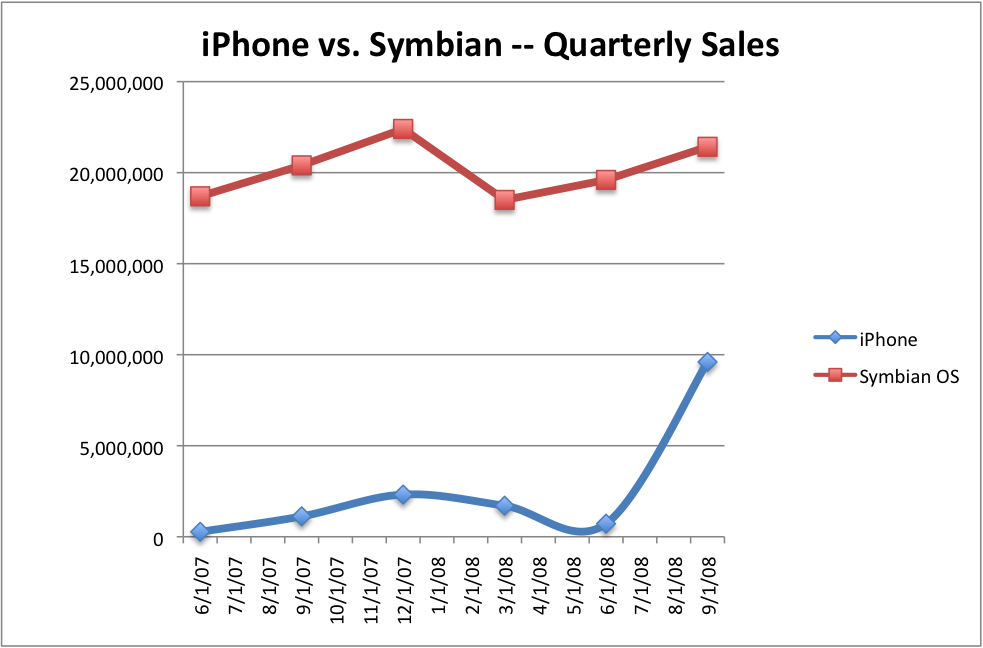The Cell Phone Industry
The industry can be thought of in terms of its major players. Here are related pages from KookyPlan...
1. The cell phone handset manufacturers
2. the telecom providers
3. the cell phone software providers
4. content providers for the Mobile Web
5. and also government regulation
Table of Contents:
Market size (massive):
Several countries, including the UK, now have more mobile phones than people. There are over five hundred million active mobile phone accounts in China, as of 2007. Luxembourg has the highest mobile phone penetration rate in the world, at 164% in December 2001. In Hong Kong the penetration rate reached 139.8% of the population in July 2007. The total number of mobile phone subscribers in the world was estimated at 2.14 billion in 2005. The subscriber count reached 2.7 billion by end of 2006 according to Informa, and 3.3 billion by November, 2007, thus reaching an equivalent of over half the planet's population. Around 80% of the world's population enjoys mobile phone coverage as of 2006. This figure is expected to increase to 90% by the year 2010
At present, Africa has the largest growth rate of cellular subscribers in the world, its markets expanding nearly twice as fast as Asian markets. The availability of prepaid or 'pay-as-you-go' services, where the subscriber is not committed to a long term contract, has helped fuel this growth in Africa as well as in other continents.
On a numerical basis, India is the largest growth market, adding about 6 million cell phones every month. With 256.55 million cell phones, market penetration in the country is still low at 22.52%. India expects to reach 500 million subscribers by end of 2010.
Growth
In less than twenty years, the mobile telephone has gone from being rare, expensive equipment of the business elite to a pervasive, low-cost personal item. In many countries, mobile telephones outnumber land-line telephones; in the U.S., 50 percent of children have mobile telephones. In many young adults' households it has supplanted the land-line telephone. The mobile phone is banned in some countries, such as North Korea.
Major Competitors (USA):
Sprint/ Nextel:
Sprint has two primary wireless networks, one for its Sprint brand of service and one for the Nextel brand. Boost Mobile for "pay as you go" predominantly runs on the Nextel network. Boost is a good deal for budget conscious customers that dont want to pay monthly contracts. At $0.10 per minute, with unlimited "push to talk" for $1 per day...its a good deal, and is a brand expanding quickly in the US. but, Boost seems to compete with another Sprint/ Nextel brand called "Virgin Mobile", of the Virgin group. Read more...http://sprintconnection.kansascity.com/?q=node/828
AT&T:
As the sole provider of the iPhone in the US, AT&T has been picking up lots of new customers, but as a result of subsidizing them, AT&T has been losing money. Is this a good deal? discuss here... and here
On the budget side, AT&T has responded to Sprints Boost mobile with a "pay as you go" phone of their own, but the rates seem to be higher (rather than $0.10 per minute, ATT charges more like $0.15...as of Oct '08).
Google gets in on the action:
to compete with iPhone...
Mobile network providers (by region)
Mobile & Silicon Valley
Silicon Valley becoming mobile innovation hub — Despite the U.S. being the laughing stock of the world for its backward mobile networks, Silicon Valley is becoming a center for mobile innovation anyway. Nokia, the large Finnish mobile phone maker, is boosting its activities in Silicon Valley, because of the action here. Nokia’s head of research here, Bob Iannucci, has even been promoted to Nokia’s chief technology officer. The Mercury News has a good story about the emergence of the valley’s strength in mobile, from Apple’s iPhone phenom to Google’s launch of its Android platform, to the surprising number of Finnish companies — BBS, Codenomicon, EB, Navicron and Tracker — that have established offices in the region. After its move to the valley, Nokia bought an intriguing company called Pixto, which lets consumers point a camera phone at an object — a building, an automobile, or a product in a store window — and with a single click call up Web data linked to the image. It uses GPS and image-matching algorithms to recognize the subject. The Mercury News argues Silicon Valley has become more important with globalization, not less.
Mobile Operating System
The battle is on for the leadership position in mobile operating system standards. See discussion here

see also :
Mobile Web
cell phone handset manufacturers
telecom providers
cell phone software
tech trends to watch
cell phone adoption in developing countries
telephone systems around the world
Comments (0)
You don't have permission to comment on this page.